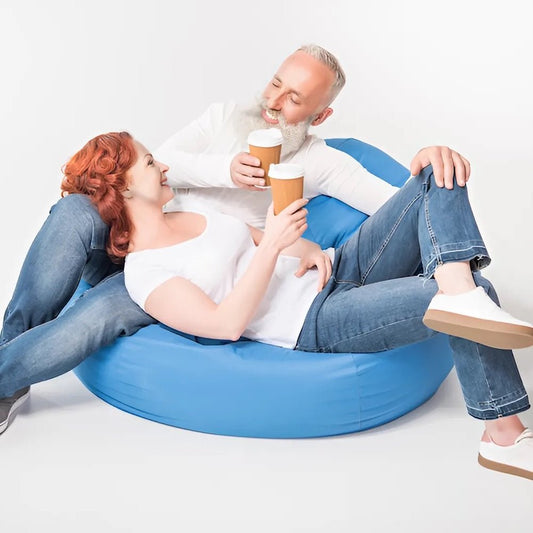Bean bag furniture is one of the most comfortable types of furniture for people of all ages, from babies to seniors, but as with any product, it must meet the proper safety standards. Bean bags have several benefits and therapeutic qualities. Leading doctors and scientists recommend them as a healthy alternative to traditional furniture. Since the mid-1990s, many people are concerned about the safety of baby bean bags. But new safety features were mandated before the end of the decade that have made bean bags safe for children of all ages. So are bean bag chairs safe for toddlers?
bean bag safety
In the 1990s, low-quality been bags were found to pose two safety hazards to small children and babies. The manufacturers have since corrected these hazards after several recalls. New regulations are now in force. However, as with all items used by children, parents are ultimately responsible for following the safety guidelines. Bean bags comprise of a lining of natural or synthetic material and a filler. Most fillers are small beads made of PVC or polystyrene but may also consist of polyurethane or Styrofoam. Most of these beads are 3 mm to 9 mm in diameter, but some bean bags may use micro-beads that are only 1 mm in diameter. The two safety risks of a bean bag for kids involve babies and small children. Children liked to open the linings and play with or attempt to eat the beads. These actions could lead to choking on them or accidentally inhaling them. Inhaling bean bag filling could block airways. In some cases, children have climbed inside of bean bags and became injured in the process. The second safety risk occurs when bean bags are not full. Bean bags must always be full to prevent accidents. A study conducted in 1996 found that 35 deaths occurred with babies who were found lying face down on a baby bean bag that is insufficiently filled. However, the researchers concluded that these deaths could have occurred in most other types of bedding through the same mechanism.
bean bag recalls and safety standards
From 1995 to 1996, several manufacturers of bean bags were forced to recall their products. HTese recalls were because of safety issues reported to the U.S. Consumer Product Safety Commission (CPSC). The CPSC is a federal regulatory agency that works to keep residents of the U.S. safe. They do this through the reduction and prevention of injuries that may be caused by products marketed to consumers. The first step in the safety process is to issue a recall of anything found to be unsafe. Next, attempts are made to develop voluntary safety standards for manufacturers. If this does not work or seems unfeasible, regulations are issued and enforced that may include mandatory safety standards or complete bans on specific products. In 1995, the CPSC issued a massive recall of 12 million bean bag chairs from ten leading manufacturers. Five other manufacturers then voluntary recalled 140,000 additional chairs. This recall prompted the CPSC to issue new safety standards regarding bean bags and bean bag furniture that were made effective in November 1996. Today, bean bags must include several safety features designed to prevent children from gaining access to the beads. Refillable bean bags must now have locking safety zippers and double stitching. This additional stitching prevents children from opening the lining and releasing the beads. Also, bean bags must now include permanent warning labels, and the fabrics must pass durability tests to ensure that children cannot rip or tear them. Parents should be knowledgeable about the dangers of cheaply made bean bags for babies or bean bags that are misused. In some instances of heavy use, the small beads may become compressed, which requires that the bags are filled with the correct amount of beads. And most manufacturers offer bead refills to ensure their products remain safe. It's important to know how to open a bean bag zipper.
child safety in the u.s.
According to the U.S. Centers for Disease Control (CDC), accidents are the leading cause of death in children under the age of five. And the New York Department of Health states that choking is the fourth prominent type of fatal accident to occur. However, choking hazards can be found everywhere and may include food, toys, clothing and other household items in addition to bedding. Nearly all of these accidents are preventable by following several guidelines:
- Do not leave children unattended.
- Enforce proper posture.
- Provide an excellent example for your children.
- Read the hazard labels on all products, and follow all recommendations.
- Educate babysitters and other caregivers about child safety.
Bean bags are deemed to be unsafe for children under the age of twelve months by the ACCC All beanbags distributed throughout Australia must carry this warning: “WARNING: Children can suffocate if bean bag filling is swallowed or inhaled. Do not let children climb inside this bean bag. A bean bag is not a safe sleeping surface for an infant under 12 months of age.” Parents should ensure that the beanbag covers have locking zippers, durable linings, and double stitching, and they must remain full of beads at all times.




